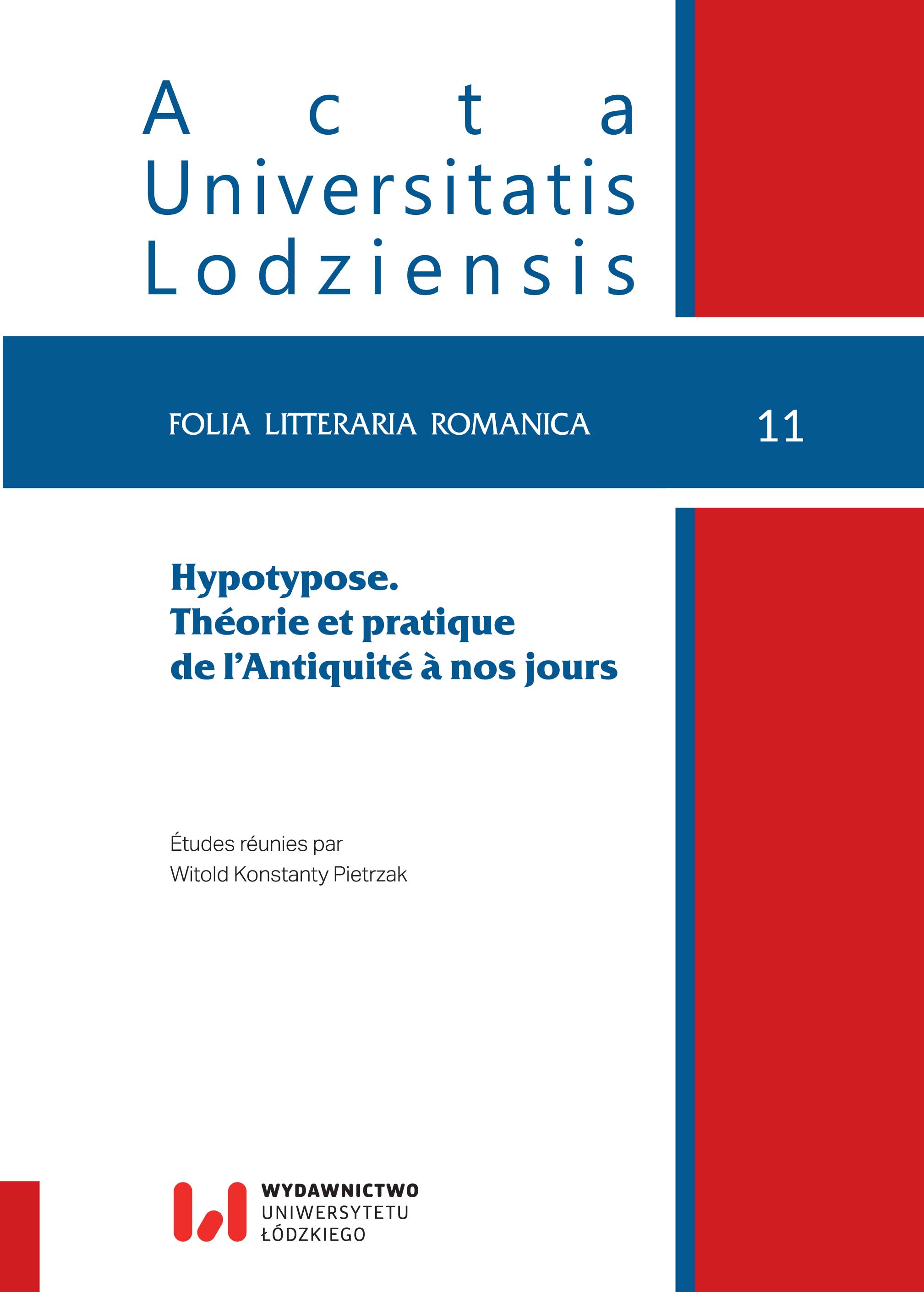Hypotypoza w Metamorfozach Owidiusza
DOI:
https://doi.org/10.18778/1505-9065.11.02Słowa kluczowe:
przemiana, ludzkie ciało, anatomia, hypotypoza, krew, retoryka, OwidiuszAbstrakt
Metamorfozy Owidiusza stanowią doskonały materiał do badań nad figurami retorycznymi, a w szczególności nad hipotypozą (euidentia). Występująca bowiem często w towarzystwie innych figur (enumeratio, accumulare res, comparatio, gradatio) hipotypoza, odgrywa wyjątkową rolę w owidiańskiej narracji, a zwłaszcza w momencie kluczowym dla każdej przemiany, jakim jest płynne przejście jednego bytu w drugi. W niniejszej pracy zostały prześledzone głównie fragmenty, które zarówno w sposób dokładny (perspicuitas), jak i przekonujący (persuasio) ukazują zmieniające się ludzkie ciało z punktu widzenia fizjonomii i anatomii. Historie Dafne, Myrry, Ocyrhoé, Aglauros czy Niobe, to tylko niektóre przykłady, które posłużyły do analiz w celu zbadania, na czym polegała istota hypotypozy w momencie przemiany. Celem artykułu było również ukazanie, w jaki sposób łaciński poeta korzystał z tej silnej pod względem natury figury retorycznej (figura ad delectandum), aby wzbudzić u czytelnika jak najgłębsze przeżycia (mouere).
Pobrania
Bibliografia
Casanova-Robin, Hélène, « Figures hybrides dans les Métamorphoses d’Ovide, l’exemple des dendrophories et leur réception chez un poète latin de la Renaissance », Aisthe, no 4, 2009, p. 18-37
Google Scholar
Calboli-Montefusco, Lucia, « Ἐνάργεια et ἐνέργεια : l’évidence d’une demonstration qui signifie les choses en acte (Rhet. Her. 4, 68) », in : Mireille Armisen-Marchetti (éd.), Demonstrare. Voir et faire voir : forme de la demonstration à Rome, Pallas, 69, Toulouse, 2005, p. 43-58
Google Scholar
Dross, Juliette, « Texte, image et imagination : le développement de la rhétorique de l’évidence à Rome », Pallas, no 93, 2013, 269-279 ; URL : http://pallas.revues.org/1513 ; consulté le 16 mars 2016
Google Scholar
Feldherr, Andrew, “Metamorphosis in the Metamorphoses”, in : The Cambridge Companion to Ovid, ed. Philip Hardie, Cambridge University Press, 2002, p. 163-178
Google Scholar
Gimaret, Antoinette, « Représenter le corps anatomisé aux XVIe et XVIIe siècles : entre curiosité et vanité », Études Épistémè, no 27, 2015 ; URL : http://episteme.revues.org/501 ; consulté le 26 juin 2016
Google Scholar
Jouteur, Isabelle, « L’image mobile de la métamorphose dans les Métamorphoses d’Ovide, ou la merveilleuse ekphrasis du monstrum (à propos de Cadmus, IV, 571-591) », Revue La Licorne, no 101, 2013 ; URL : http://licorne.edel.univ-poitiers.fr/document5384.php ; consulté le 28 juin 2016
Google Scholar
Lausberg, Heinrich, Handbook of Literary Rhetoric: A Foundationf or Literary Study. Foreword by George A. Kennedy. Trans. Matthew T. Bliss, Annemiek Jansen, Jansen and David. Orton, ed. David. E. Orton, R. Dean Anderson, Leiden, E.J. Brill, 1998
Google Scholar
Le Bozec, Yves, « L’hypotypose : un essai de définition formelle », L’Information Grammaticale, no 92, 2002, p. 3-7
Google Scholar
Néraudau, Jean-Pierre, Ovide ou les dissidences du poète, Paris, Hystrix, 1989
Google Scholar
Ovide, Les Métamorphoses, texte établi et traduit par Georges Lafaye, Paris, Les Belles Lettres, t. I, (I-V), 1961 ; t. II (VI-X), 1965 ; t. III (XI-XV), 1930
Google Scholar
Plett, Heinrich F., Enargeia in Classical Antiquity and the Early Modern Age, Brill, 2012
Google Scholar
Quintilien, Institution oratoire, texte établi et traduit par Jean Cousin, Paris, Les Belles Lettres, t. IV (liv. VI-VII), 1977 ; t. V (liv. VIII-IX), 1978
Google Scholar
Rivère de Carles, Nathalie, « Sous la lame, point d’essence ? L’excoriation dans le théâtre de la Renaissance », Revue Epistémocritique, Littérature et Savoirs, 2012, n.p. ; URL : www.epistemocritique.org/spip.php?article285&lang=fr ; consulté le 27 juin 2016
Google Scholar
Vial, Hélène, La Métamorphose dans les Métamorphoses d’Ovide. Étude sur l’art de la variation, Paris, Les Belles Lettres, 2010
Google Scholar
Zangara, Adriana, Voir l’histoire. Théories anciennes du récit historique, IIe siècle avant J.-C. – IIe après J.-C., Paris, Vrin, 2007
Google Scholar
Pobrania
Opublikowane
Jak cytować
Numer
Dział
Licencja

Utwór dostępny jest na licencji Creative Commons Uznanie autorstwa – Użycie niekomercyjne – Bez utworów zależnych 4.0 Międzynarodowe.













